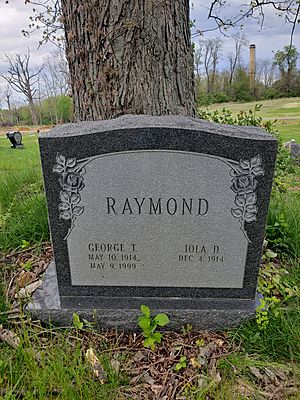George Raymond facts for kids
Quick facts for kids
George Raymond
|
|
|---|---|
| Born | May 10, 1914 Chester, Pennsylvania, U.S.
|
| Died | May 9, 1999 (aged 84) |
| Resting place | Haven Cemetery, Chester, Pennsylvania, U.S. |
| Occupation | President of the Chester, Pennsylvania branch of the NAACP |
George T. Raymond (born May 10, 1914 – died May 9, 1999) was an important American leader. He worked for civil rights, which means equal rights for all people. Raymond led the National Association for the Advancement of Colored People (NAACP) in Chester, Pennsylvania. He was president of the Chester NAACP from 1942 to 1977.
Raymond helped end segregation in Chester. Segregation meant keeping Black and white people separate. He worked to desegregate businesses, public housing, and schools. He also helped lead the Chester school protests in 1964. These protests made Chester a key place in the Civil Rights Movement.
Contents
Early Life and Education
George Raymond was born in Chester, Pennsylvania. He went to Chester High School and finished in 1933. After high school, he studied business at Drexel Institute of Technology.
But he had to leave school after one year. Money was tight, so he needed to find a job. Raymond worked many different jobs. Later, he found work at the Chester Boys Club. He also joined the NAACP, which started his journey in the civil rights movement.
Leading the Civil Rights Movement
Raymond became the leader of the Chester NAACP in 1942. He started programs to fight racial discrimination. Discrimination is when people are treated unfairly because of their race. He worked with J. Pius Barbour, a pastor from Calvary Baptist Church. Together, they worked step-by-step to achieve civil rights.
Ending Segregation in Chester
In 1945, Raymond and the Chester NAACP achieved a big win. They successfully desegregated movie theaters, restaurants, and hotels in Chester. They used peaceful protests to do this. They also threatened to take legal action if businesses did not change.
In 1955, Raymond and the NAACP helped desegregate public housing. This housing was managed by the Chester Housing Authority. This meant Black and white families could live in the same housing areas.
Fighting School Segregation
In 1953, the U.S. Supreme Court made an important decision. In the case of Brown v. Board of Education, the court said that separate schools for Black and white students were against the law.
The Chester School Board said they were integrating. However, they let white students transfer to other schools easily. Black students were rarely allowed to transfer. This meant many schools in Chester were still mostly Black. White students living near these schools went to all-white schools elsewhere.
The Chester School Protests
In 1964, major protests happened in Chester. These were called the Chester school protests. They lasted for a month. Stanley Branche and the Committee for Freedom Now led these protests. They were against the school board's unfair segregation.
The protests sometimes involved violence and police action. James Farmer, another civil rights leader, called Chester the "Birmingham of the North." This was because of how protesters were treated, similar to Birmingham, Alabama.
Raymond gave the school board a list of 10 demands. These included moving teachers, transporting students to different schools, and hiring more Black people for important jobs. Over 600 people were arrested during these protests. These events included rallies, marches, boycotts, and sit-ins.
Personal Challenges
In 1958, Raymond bought a house in Rutledge, Pennsylvania. This area was mostly white. The day before he moved in, his new house burned down. After the fire, the town tried to take his property. They wanted to build a new town hall there. Raymond threatened to sue them, and the town gave up. His house was rebuilt, and he moved in during 1959.
Legacy and Recognition
George Raymond passed away on May 9, 1999, from heart failure. He was buried at Haven Memorial Cemetery.
He received the Freedom Award from Supreme Court Justice Thurgood Marshall. This was a great honor for his work. In 1991, the NAACP created the George T. Raymond award in his honor.
Raymond also created three scrapbooks. These books contain newspaper clippings, booklets, and photos. They show the civil rights movement in Chester during the 1940s, 1950s, and 1960s. You can find these scrapbooks online at Widener University.
See also


